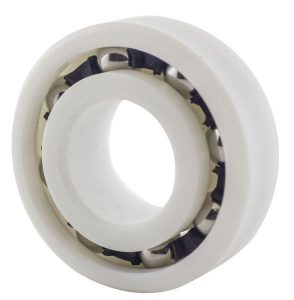
Bearings are an important part of many machines. Consisting of a donut-shaped piece of material, they are designed to restrict or limit the motion of a machine’s moving parts while also reducing friction between the machine’s moving parts in the process. They are known as “bearings” because they “bear” the stress of a machine’s moving parts. While all bearings support the machines with which they are used, however, they are available in many different types, including thrust bearings.
Overview of Thrust Bearings
Thrust bearings are rotary bearings that are designed specifically to support an axial load. In other words, they are capable of rotating along with a machine’s parts. Thrust bearings, in fact, assist in the rotation of a machine’s moving parts. As a machine’s moving parts begin to rotate, they’ll glide along the thrust bearings.
How Thrust Bearings Work
Most thrust bearings use balls to support the machines with which they are used. Known as “thrust ball bearings,” they contain many small metal balls in a band around the perimeter. You can see an example of a thrust ball bearing in the photo above. Thrust ball bearings such as this are used in applications where a machine’s moving parts apply an axial load. With their arrangement of balls, they are able to assist with the rotation of a machine’s moving parts.
There are other types of thrust bearings as well. In addition to thrust ball bearings, there are cylinder thrust bearings. Cylinder thrust bearings feature cylindrical-shaped rollers that point towards the axis. Another type of thrust bearing is magnetic. Magnetic thrust bearings live up to their namesake by producing a magnetic field. They are made of ferromagnetic materials that produce a magnetic field. The presence of this magnetic field helps to support the axial thrust. Of all the different types, though, none are more popular than ball thrust bearings.
Tips on Choosing Thrust Bearings
When shopping for thrust bearings, there are a few things you should know. Thrust bearings are available in different sizes. You’ll need to choose a size that matches the application for which you intend to use it. If a thrust bearing it too big or too small for a machine’s moving parts, you may not be able to use it. Fortunately, you can order thrust bearings in a variety of standard sizes and metric sizes.
Something else to consider when choosing thrust bearings is the ball material. Thrust bearings featuring cheap balls tend to degrade quickly. Over time, the balls may lose their clean and smooth texture, resulting in increased resistance and reduced performance. But you can find thrust bearings with many high-quality ball materials. Some of them have glass balls, whereas others have stainless steel balls. Both glass and stainless steel are high-quality ball materials that last a long time.
